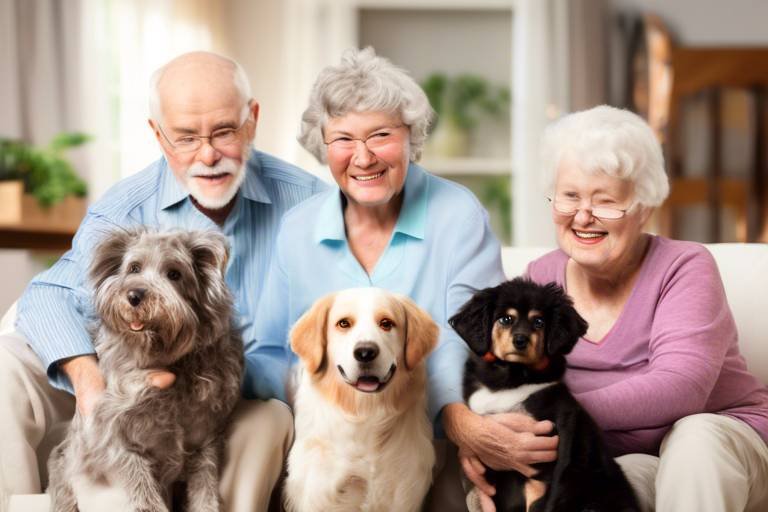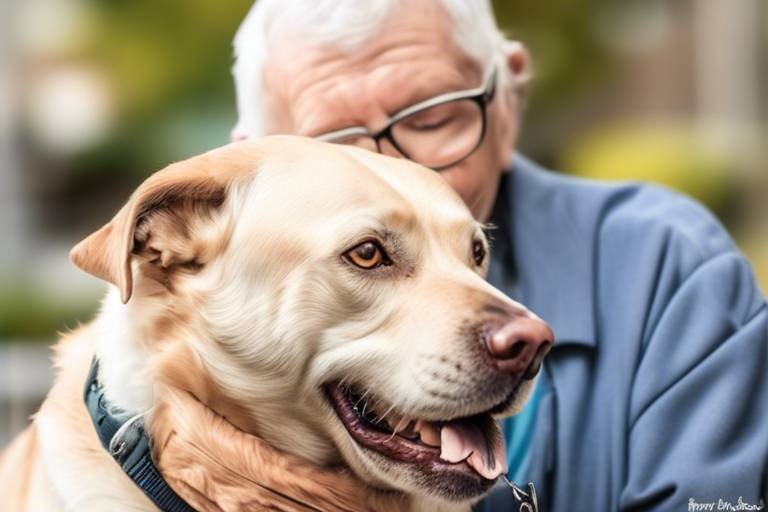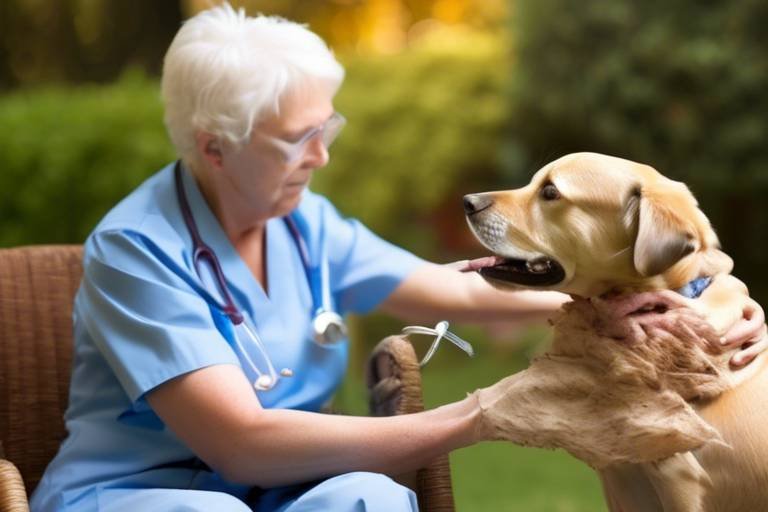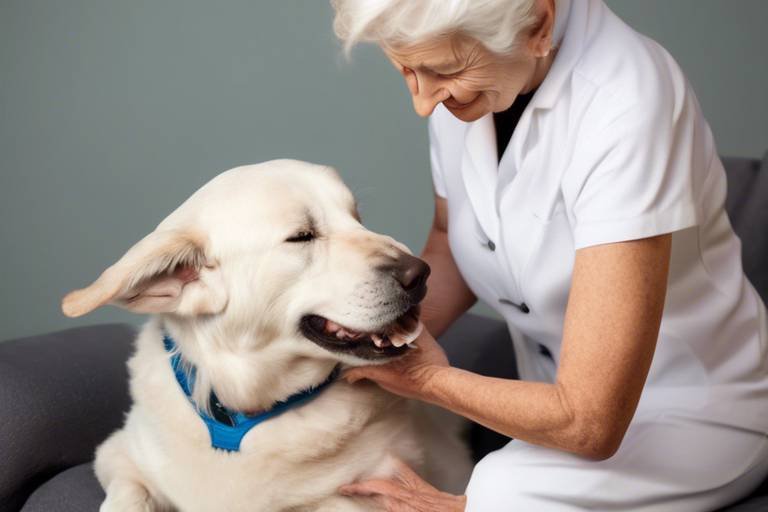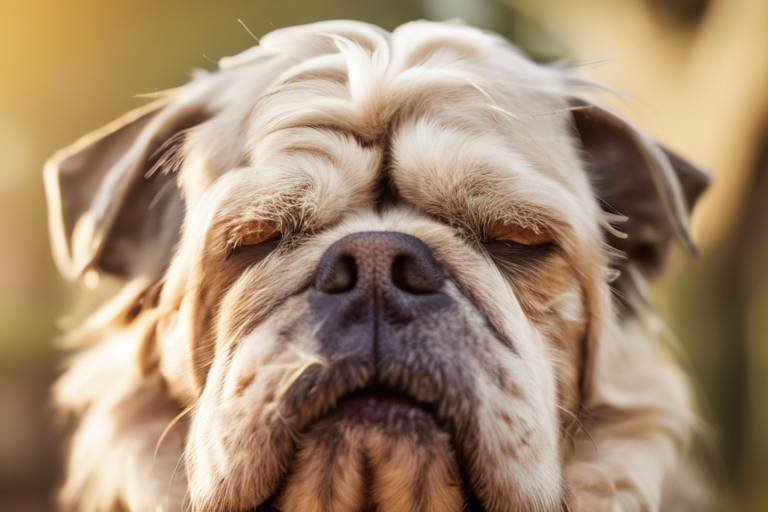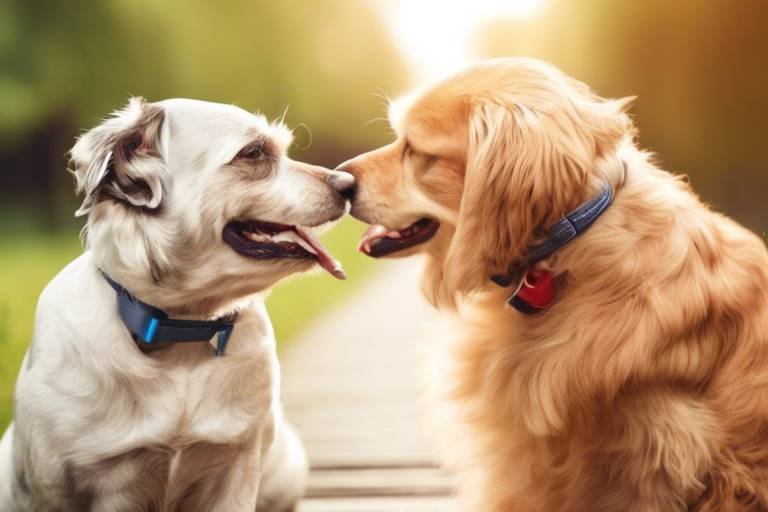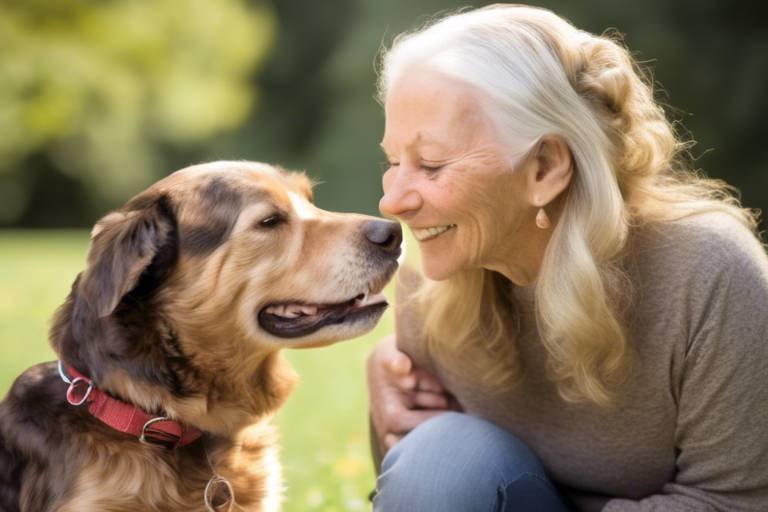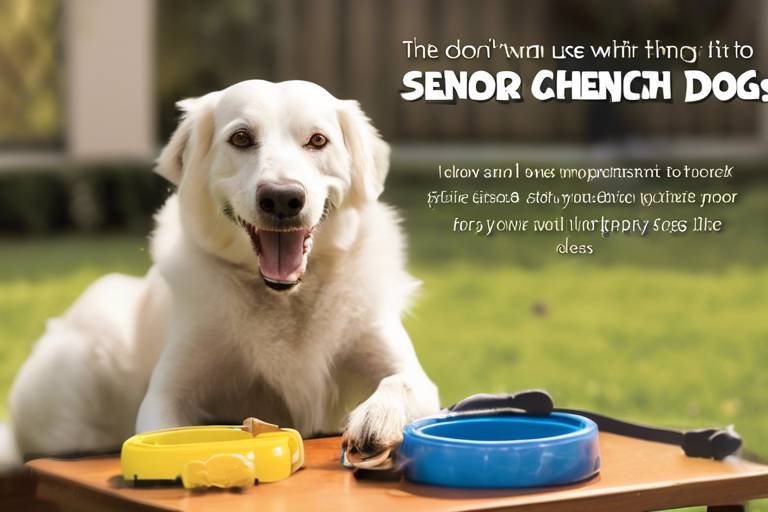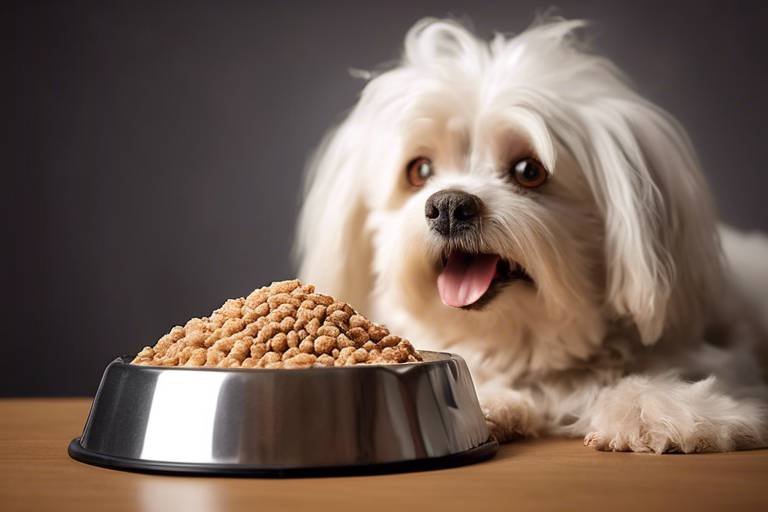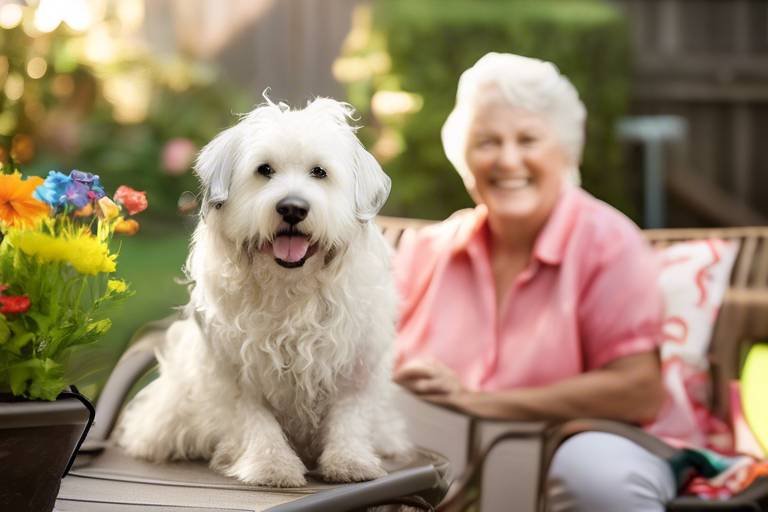Tips for Managing a Multi-Pet Household with Seniors
Living in a multi-pet household can be a delightful yet challenging experience, especially when some of your furry friends are seniors. As our pets age, they often require extra care and attention to ensure they remain happy and healthy. This article provides practical advice for ensuring a harmonious environment when living with multiple pets and senior animals, focusing on their unique needs and interactions. With a little effort and understanding, you can create a loving home where all your pets, young and old, can thrive together.
Senior pets are like the wise elders of the animal kingdom, bringing years of experience and love into our lives. However, they also come with their own set of physical and emotional needs. For instance, as pets age, they may experience health issues such as arthritis, vision impairment, or cognitive decline. Understanding these challenges is key to creating a comfortable environment that promotes their well-being and happiness. Regular vet check-ups become essential, as they can help identify specific health concerns and provide tailored advice to meet your senior pet's needs.
Safety is paramount in a multi-pet household. Implementing measures to minimize hazards can significantly enhance the quality of life for senior pets and prevent accidents. Imagine your home as a sanctuary where every corner is designed for comfort and safety. This means keeping hazardous items out of reach, securing loose wires, and ensuring that all areas are well-lit. The goal is to create a space where your pets can roam freely without the constant worry of injury.
Establishing specific areas for each pet can reduce stress and territorial disputes. Think of it as creating a personal oasis for each of your furry friends. This is especially important for senior pets, who may need their own safe spaces to retreat to when they feel overwhelmed. By designating areas, you can ensure that every pet has a place to relax and feel secure.
Providing cozy and accessible resting spots is crucial for senior pets. Soft bedding that supports their joints can make a world of difference. Consider placing these spots in quiet corners of your home, away from the hustle and bustle. Easy access to these resting areas can help them feel secure and comfortable, allowing them to recharge when needed.
Maintaining clear pathways throughout the home can assist senior pets in moving safely. Think of it as creating a clear runway for them to navigate. Removing obstacles reduces the risk of falls and injuries, promoting independence. Regularly check for any items that might be in the way, and keep their favorite routes clear.
Supervising interactions between senior pets and younger animals is essential. This helps to ensure that the dynamics remain positive and that all pets feel secure and respected. Sometimes, younger pets may not realize their strength and energy can be overwhelming to a senior. By keeping an eye on their interactions, you can intervene if necessary, preventing any potential stress or conflict.
Proper nutrition is vital for senior pets. Just like humans, as pets age, their dietary needs change. Tailoring their diets to meet their specific health needs can enhance their quality of life and longevity. For example, senior pets may benefit from diets lower in calories but higher in fiber to aid digestion. Always consult with your veterinarian to determine the best dietary plan for your furry friend.
Regular veterinary consultations can help determine the best dietary plan for senior pets. Professional guidance ensures that their nutritional needs are adequately met. Your vet can recommend specific brands or types of food that cater to their age-related requirements, making it easier for you to provide the best for your beloved pet.
Ensuring that senior pets stay hydrated is crucial for their health. Just like us, pets need access to fresh water at all times. Monitoring their intake can prevent dehydration and related health issues. Consider using pet water fountains, as many pets are attracted to running water and may drink more as a result.
Engaging senior pets in regular exercise and mental stimulation is important for their physical and mental health. Tailored activities can keep them active and alert. Think of exercise as a way to keep the wheels turning in their minds and bodies. Gentle walks, light play, or even simple games can work wonders in maintaining their vitality.
Implementing gentle exercise routines, such as short walks or light play, can help maintain mobility and prevent obesity in senior pets. These activities should be tailored to their abilities, ensuring they're not overexerted. Remember, it's not about how long the exercise lasts, but rather the quality of the time spent together.
Using interactive toys can stimulate a senior pet's mind, keeping them engaged and entertained. These toys can also promote physical activity in a fun way. Look for toys that challenge their problem-solving skills without being too strenuous. This can be a great way to bond while keeping them active.
Creating a consistent daily routine can help senior pets feel secure and reduce anxiety. Predictability in feeding, exercise, and rest times is beneficial for their overall well-being. Just like humans, pets thrive on routine, and knowing what to expect can make their day-to-day life much more comfortable.
A regular feeding schedule can aid in digestion and establish a sense of security for senior pets, making meal times a stress-free experience. Try to feed them at the same times each day, and be mindful of their dietary restrictions and preferences.
Daily check-ins can help monitor the health and behavior of senior pets, allowing for early detection of any changes that may require veterinary attention. This simple act can make a big difference in their overall health and happiness, ensuring they receive the care they need when they need it.
- What are the signs that my pet is aging? Look for changes in energy levels, mobility issues, changes in appetite, and increased sleeping.
- How can I help my senior pet stay active? Engage them in gentle exercise routines and provide interactive toys to keep their minds sharp.
- What dietary changes should I make for my senior pet? Consult with your veterinarian for tailored dietary advice, focusing on lower calories and higher fiber as needed.
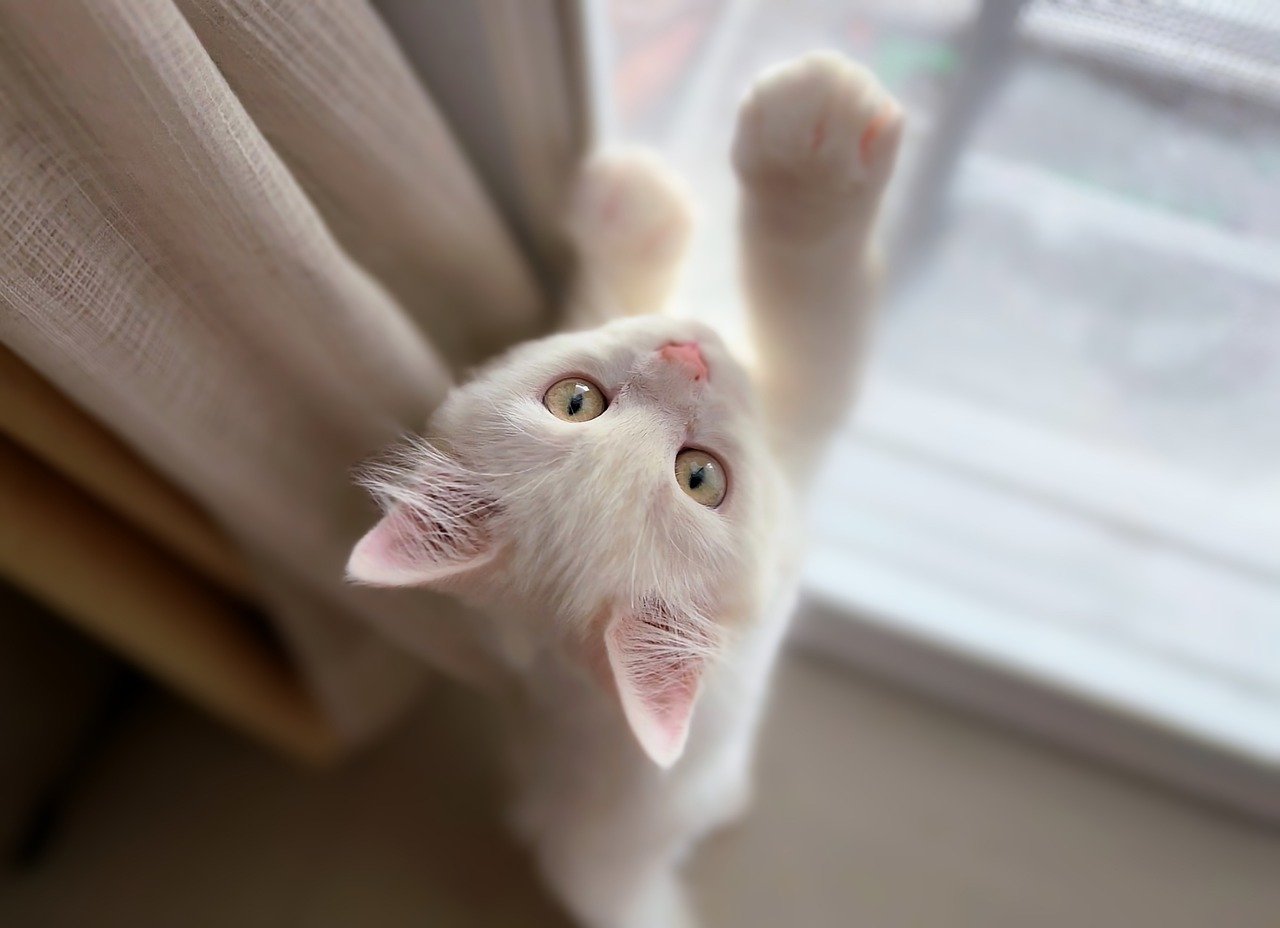
Understanding Senior Pet Needs
As our furry companions age, their needs evolve significantly, requiring us to adapt our care strategies to ensure they live their golden years comfortably and happily. Senior pets often face a myriad of physical and emotional challenges that can impact their quality of life. For instance, they may experience reduced mobility, diminished senses, and increased anxiety. Understanding these changes is crucial for providing a supportive environment.
One of the most noticeable changes in senior pets is their physical health. Just like humans, aging pets may suffer from conditions such as arthritis, which can make movement painful and difficult. This is where gentle care becomes essential. Providing a soft, warm bed and ensuring they have easy access to food and water can make a world of difference. Additionally, senior pets often have specific dietary needs. Their metabolism slows down, and they may require fewer calories but more nutrients. Consulting with a veterinarian about the best diet can help in maintaining their health and vitality.
Moreover, emotional well-being is just as important as physical health. Senior pets may experience anxiety or depression, especially if they have lost a companion or are facing changes in their environment. It’s vital to maintain a consistent routine that includes regular interaction, affection, and mental stimulation. Engaging them in gentle play or simply spending time together can alleviate feelings of loneliness and keep their spirits high.
To better understand the needs of senior pets, consider the following aspects:
- Mobility: Look for signs of discomfort when your pet moves. Providing ramps or soft surfaces can help.
- Senses: Senior pets may have impaired vision or hearing. Ensure their environment is safe and familiar.
- Nutrition: A balanced diet tailored to their age can help manage weight and health issues.
- Routine: Keeping a predictable daily schedule can help reduce anxiety and provide comfort.
In summary, understanding the unique needs of senior pets is not just about acknowledging their age; it's about actively adapting to their changing requirements. By focusing on their physical and emotional health, we can create a nurturing environment that allows them to thrive, ensuring their twilight years are filled with joy and comfort.
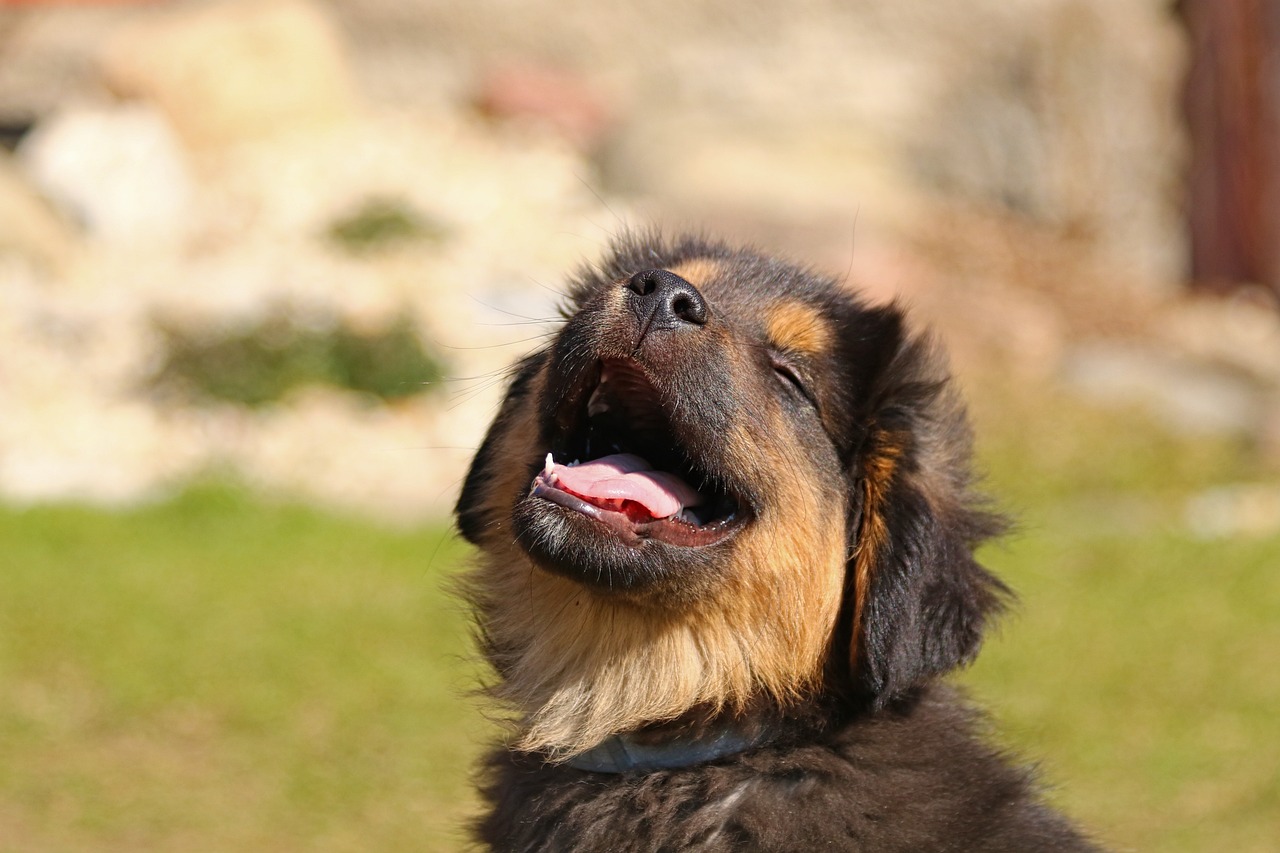
Creating a Safe Environment
Creating a safe environment for senior pets in a multi-pet household is not just a good idea; it's essential for their well-being. Senior pets often face challenges such as decreased mobility, sensory decline, and varying health issues that can make their living situation more complicated. By taking proactive steps to minimize hazards, you can significantly enhance their quality of life and ensure they feel secure in their surroundings.
One of the first steps in establishing a safe environment is to designate specific areas for each pet. This can help reduce stress and territorial disputes. For instance, if you have a senior dog who prefers a quieter space, creating a cozy corner with their bed and toys can provide them with a retreat when they need a break from the hustle and bustle of younger, more energetic pets. This not only helps the senior pet feel secure but also teaches younger pets to respect boundaries.
Providing comfortable resting spots is crucial. Senior pets often require more rest, and having a designated, soft, and accessible bed can make a world of difference. Think of it as creating a little sanctuary for them. If you have multiple pets, ensure that each one has its own space to lie down without feeling crowded. You might consider using orthopedic beds for dogs or cats that suffer from joint pain, as these can provide better support and comfort.
Maintaining clear pathways throughout the home is another vital aspect of creating a safe environment. As pets age, their vision and mobility can decline, making it harder for them to navigate their surroundings. By removing obstacles—like clutter, rugs that could be tripped over, or low furniture—you can reduce the risk of falls and injuries. Consider this: if you were walking through a dark room, wouldn’t you want a clear path to avoid stubbing your toe? Your pets deserve the same consideration.
Additionally, you can enhance safety by using non-slip mats in areas where pets frequently walk, especially on slippery floors. This simple step can provide extra traction and prevent accidents. Regularly check the environment for potential hazards, such as exposed wires or toxic plants, and take the necessary steps to eliminate them.
Finally, monitoring interactions between senior pets and younger animals is essential. While younger pets often have a playful spirit, they may not realize their strength or how their behavior affects older companions. Supervision during playtime can help ensure that all pets feel secure and respected. It’s important to intervene if play becomes too rough or if a senior pet appears stressed or overwhelmed. Think of it as a referee in a game; your role is to maintain harmony and ensure everyone plays fair.
By implementing these strategies, you can create a safe and nurturing environment for your senior pets. Remember, their comfort and security should always be a priority, and a little effort can lead to a significantly happier household for everyone involved.
- What are the signs that my senior pet is feeling unsafe? Look for signs such as hiding, excessive barking, or reluctance to move around the house.
- How can I make my home more accessible for my senior pet? Consider adding ramps, using pet stairs, and ensuring that their favorite spots are easy to access.
- Should I separate my pets? If there are ongoing conflicts or stress, it may be beneficial to create separate spaces for each pet.
Designating Pet Areas
Creating designated areas for each of your pets is a crucial step in managing a multi-pet household, especially when you have senior animals in the mix. Think of it as creating a cozy little sanctuary for each furry friend. Just like humans, pets thrive in environments where they feel secure and at ease. By establishing specific areas for your pets, you can significantly reduce stress and prevent territorial disputes, which can be particularly important for senior pets who may be more sensitive to changes in their environment.
When setting up these areas, consider the unique needs of your senior pets. For example, they may require quieter spaces away from the hustle and bustle of younger, more energetic pets. This can be as simple as designating a corner of a room with their favorite bed or blanket, where they can retreat when they need a break. You might also want to think about the accessibility of these areas. If your senior pet has mobility issues, ensure that their designated space is easily reachable without any obstacles in the way.
Here are some tips to help you effectively designate pet areas:
- Size Matters: Ensure that each area is spacious enough for your pet to move around comfortably. A cramped space can lead to anxiety.
- Comfort is Key: Equip each area with comfortable bedding, toys, and maybe even a favorite blanket. This will encourage your pets to use their designated spots.
- Visual Barriers: Use furniture or pet gates to create clear boundaries between different pet areas. This helps in reducing confrontations and gives each pet their own space.
Additionally, it's essential to monitor how your pets interact in these designated areas. Sometimes, younger pets may not realize the need for a senior pet's space. Keeping an eye on their interactions can help ensure that everyone is respecting each other's boundaries. If you notice any signs of stress or aggression, it may be necessary to adjust the layout or the rules of engagement within your home.
By thoughtfully designating areas for your pets, you not only enhance their comfort but also promote a more harmonious living environment. This small change can make a world of difference in the overall dynamics of your multi-pet household, ensuring that every furry friend feels valued and secure, especially your beloved seniors who deserve that extra bit of care and consideration.
Q: How do I know if my senior pet needs a designated area?
A: If your senior pet seems anxious, seeks solitude, or is frequently disturbed by younger pets, it's a good indication that they would benefit from their own space.
Q: Can I use the same area for multiple pets?
A: While it's possible, it's best to provide separate areas to reduce stress and potential conflicts, especially if one pet is more dominant than the others.
Q: What if my pets do not respect the designated areas?
A: Training and supervision are key. You may need to reinforce boundaries through gentle correction and positive reinforcement when they respect each other's spaces.
Comfortable Resting Spots
Creating for senior pets is not just a luxury; it's a necessity. As our beloved furry friends age, their bodies become more fragile, and they often seek out places that provide warmth and security. Imagine how you feel after a long day—now think about your pet's experience as they navigate their golden years. They deserve a cozy nook that feels like a safe haven.
When setting up these resting spots, consider the following elements:
- Soft Bedding: Choose bedding that is not only soft but also supportive. Orthopedic beds can help alleviate joint pain and provide the comfort that older pets need.
- Accessibility: Ensure that the resting spots are easy for your senior pets to access. Low beds or cushions are ideal, as they minimize the effort needed to climb in and out.
- Location: Select quiet areas away from the hustle and bustle of family activities. A peaceful corner can greatly enhance their sense of security.
It's also essential to rotate these spots if you have multiple pets. This way, each pet can have their own cozy area while still feeling part of the family unit. You might even consider creating a few different resting spots throughout your home, so your pet can choose their favorite location depending on their mood.
In addition to the physical comfort, think about the temperature. Senior pets are often more sensitive to temperature changes, so providing a warm blanket during colder months can make a world of difference. A well-placed heating pad or a pet-safe heated bed can also offer additional comfort. Just be sure to monitor the temperature to avoid overheating.
Finally, don’t forget about the importance of cleanliness. Regularly wash the bedding and keep the resting areas free from debris or clutter. A clean environment not only promotes better health but also contributes to a sense of well-being for your senior pets. After all, a happy pet is a healthy pet!
Q: How often should I replace my senior pet's bedding?
A: It's a good idea to replace bedding every 6-12 months, or sooner if it shows signs of wear and tear. Keeping their resting spots fresh helps maintain their comfort.
Q: Can I use human beds for my senior pets?
A: While some pets may enjoy sleeping on human beds, it’s important to ensure they have their own designated spots that cater to their specific needs.
Q: What are the signs that my senior pet needs a new resting spot?
A: If your pet seems restless, has difficulty getting comfortable, or avoids their current resting area, it might be time to reassess their sleeping arrangements.
Clear Pathways
Creating throughout your home is essential for the safety and independence of senior pets. As our furry friends age, they may experience reduced mobility, vision problems, or even cognitive decline, making it crucial to ensure their environment is as accessible as possible. Imagine navigating a maze filled with obstacles—frustrating, right? Now, think about how your senior pet feels when they have to maneuver around furniture, toys, or other hazards. By eliminating these barriers, you can significantly enhance their quality of life.
Start by evaluating your living space. Look for common areas where your pets frequently roam and identify potential hazards. Here are some tips to help you maintain clear pathways:
- Remove Clutter: Keep floors free of clutter, such as shoes, bags, and other items that could trip up your pets. A clean space not only looks better but also helps prevent accidents.
- Use Non-Slip Rugs: If you have slippery floors, consider using non-slip rugs or mats. This can provide better traction for senior pets, making it easier for them to move around safely.
- Adjust Furniture Placement: Rearranging furniture to create wider pathways can make a world of difference. Ensure that there is enough space for your pets to walk comfortably without feeling cramped.
Additionally, consider installing ramps or steps if your home has stairs. This can help senior pets navigate up and down without putting too much strain on their joints. Remember, every little change counts! Keeping pathways clear not only promotes physical safety but also contributes to a sense of security and comfort for your beloved companions.
Ultimately, a well-organized living space that prioritizes clear pathways will allow your senior pets to maintain their independence while minimizing the risk of falls and injuries. Just like we appreciate a tidy, safe environment, so do our pets. It's all about creating a harmonious home where every member—human and animal—can thrive!
Q: What are some signs that my senior pet is having difficulty moving around?
A: Look for signs such as hesitance to jump, difficulty climbing stairs, or a reluctance to engage in play. Changes in behavior, like increased lethargy or avoidance of certain areas, can also indicate mobility issues.
Q: How can I make my home more senior-pet friendly?
A: To make your home more senior-pet friendly, consider adding ramps, removing obstacles, and providing cozy resting spots. Ensuring that food and water bowls are easily accessible is also important.
Q: Should I consult a veterinarian if I notice changes in my senior pet's movement?
A: Yes, consulting a veterinarian is always a good idea if you notice any changes in your pet's movement. They can provide guidance and suggest appropriate interventions or treatments.
Monitoring Interactions
When you have a multi-pet household, especially with senior pets, becomes crucial. Just like humans, pets have their own personalities, and while some may get along famously, others might not see eye to eye. Imagine a family reunion where everyone is supposed to get along, but there’s that one uncle who just can’t stop arguing! In the same way, pets can have their own dynamics that need careful observation.
One of the best ways to ensure a peaceful environment is to supervise all interactions between senior pets and younger animals. This doesn’t mean you have to hover over them constantly, but being present during playtime or feeding can help you catch any signs of discomfort or aggression before they escalate. For example, if you notice a younger pet getting too rambunctious with a senior, it’s essential to intervene gently. You could say something like, “Hey buddy, let’s tone it down a bit!” This not only protects the senior but also teaches the younger pet about boundaries.
It’s also beneficial to observe the body language of your pets. Signs of stress in senior pets can include:
- Tail tucked between the legs
- Hiding or retreating to a safe space
- Growling or hissing
- Excessive panting or pacing
On the flip side, younger pets may display signs of overexcitement or dominance, such as barking excessively, jumping, or trying to take toys away. If you notice these behaviors, it’s a good idea to separate the pets for a brief period to allow the senior pet some much-needed peace. Think of it as giving them a little “me time” to recharge.
Creating a positive atmosphere is key, and one way to do this is by rewarding good behavior. When you notice your younger pet interacting gently with the senior, shower them with praise or a treat. This reinforces the behavior and encourages them to continue being considerate. It’s like giving a gold star for good behavior in school!
Lastly, consider implementing structured playtimes where you can engage both senior and younger pets in activities that promote bonding and reduce stress. For example, using a long rope toy that allows for gentle tug-of-war can be a great way to engage both age groups without putting too much physical strain on the seniors. Just remember, the goal is to keep interactions positive and enjoyable for everyone involved!
- How can I tell if my senior pet is stressed during interactions?
- Look for signs such as hiding, excessive vocalization, or physical signs like a tucked tail. If your senior pet seems uncomfortable, it’s best to separate them from the younger pets.
- What activities are suitable for both senior and younger pets?
- Gentle games like fetch with soft toys, supervised tug-of-war, or even puzzle toys can engage both age groups without overexerting the senior pets.
- Should I intervene during playtime?
- Yes, it’s important to monitor their interactions. If you see any signs of aggression or discomfort, intervene calmly to prevent any potential issues.
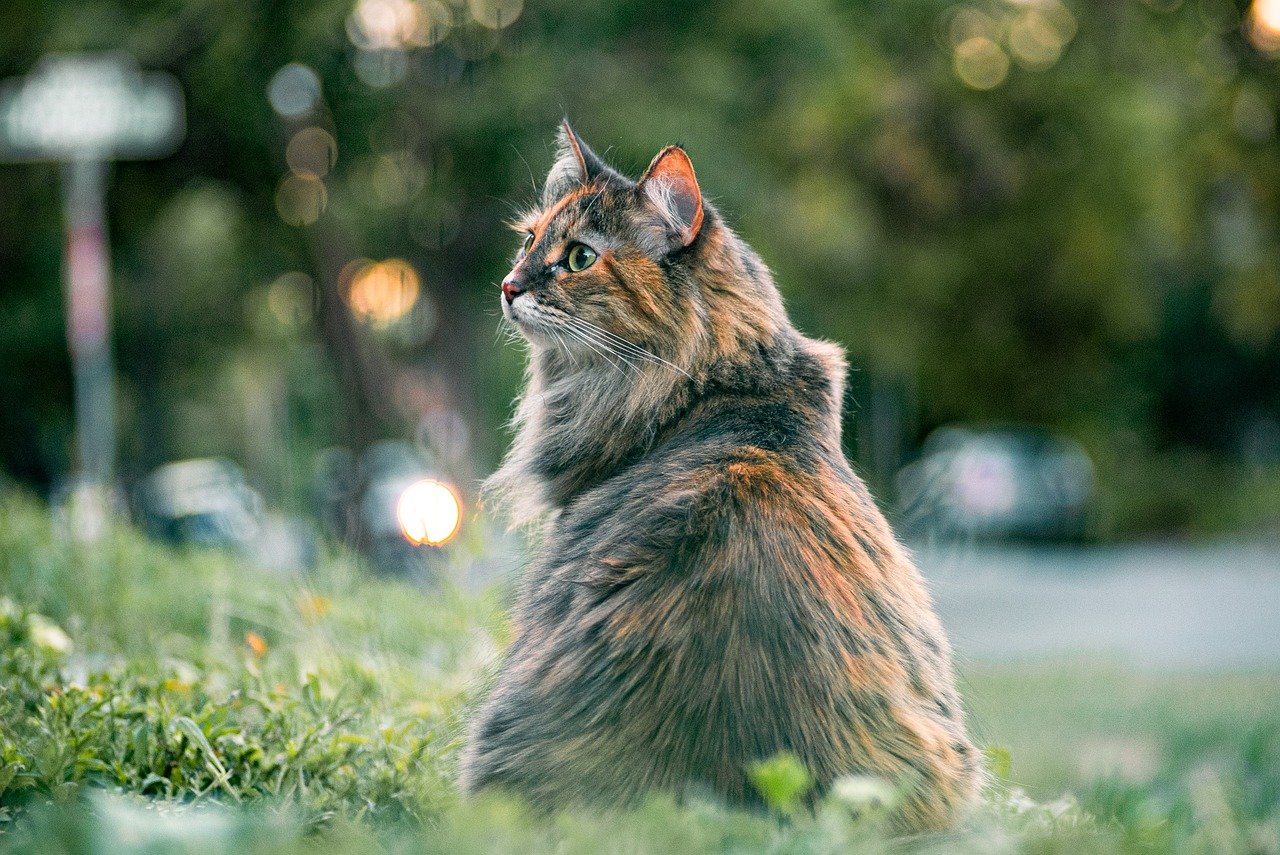
Nutrition for Senior Pets
When it comes to the golden years of our furry companions, nutrition plays a pivotal role in ensuring their health and happiness. Just like us, senior pets have unique dietary requirements that can significantly impact their quality of life. As pets age, their metabolism slows down, and they may develop specific health issues, making it essential to tailor their diets accordingly. But how do you know what’s best for your beloved pet?
First and foremost, it’s crucial to consult with a veterinarian. Regular check-ups can help identify any health concerns and provide tailored dietary recommendations. A vet can suggest specific food brands or types that cater to your pet's needs, ensuring they receive the right balance of nutrients. For example, senior pets often benefit from diets that are lower in calories but higher in fiber to aid digestion and maintain a healthy weight. Additionally, some pets may require special diets to manage conditions like kidney disease or arthritis.
Another important aspect of senior pet nutrition is hydration. As pets age, their ability to sense thirst may diminish, which can lead to dehydration. It’s vital to provide fresh, clean water at all times and monitor their intake. You might consider using pet water fountains, which can encourage drinking, or adding water to their dry food to increase hydration. Remember, keeping your senior pet hydrated is just as important as their food!
Here’s a quick overview of some key nutritional components to consider for senior pets:
| Nutritional Component | Importance |
|---|---|
| Protein | Helps maintain muscle mass and supports overall health. |
| Fiber | Aids in digestion and helps prevent obesity. |
| Omega Fatty Acids | Supports joint health and promotes a healthy coat. |
| Antioxidants | Boosts the immune system and combats aging. |
Incorporating these components into your senior pet’s diet can make a world of difference. However, it's essential to introduce any new food gradually to avoid digestive upset. Start by mixing their current food with the new diet, slowly increasing the proportion of the new food over a week or so.
Lastly, don’t forget to observe your pet’s reaction to changes in their diet. Are they more energetic? Do they seem to enjoy their meals? Monitoring their weight and overall health will help you adjust their diet as needed. After all, a well-fed senior pet is a happy pet!
- What should I feed my senior pet? It's best to feed them high-quality food that is specifically designed for senior pets. Consult your vet for personalized recommendations.
- How much water should my senior pet drink? Ensure fresh water is available at all times, and monitor their intake, as hydration needs can vary.
- Can I give my senior pet treats? Yes, but opt for healthy treats and consider their overall caloric intake to prevent obesity.
Consulting with a Veterinarian
When it comes to the health and well-being of our beloved senior pets, consulting with a veterinarian is not just a good idea; it's essential. Senior pets often face unique health challenges that require specialized knowledge and care. Just like we visit our doctors for regular check-ups as we age, our furry friends need that same level of attention. This proactive approach can help catch potential health issues early, ensuring that our pets live their golden years as comfortably as possible.
During your visits, make sure to discuss any changes you've noticed in your pet's behavior, eating habits, or mobility. These seemingly minor observations can provide valuable insights for the veterinarian. For instance, if your dog has suddenly become less interested in playtime or your cat seems to be sleeping more than usual, these can be signs of underlying health issues. Don't hesitate to jot down your concerns before the visit; it can help you remember to cover everything important during your consultation.
Moreover, your vet can recommend a tailored dietary plan that suits the specific health needs of your senior pet. For example, some pets may require low-protein diets due to kidney issues, while others may benefit from supplements to support joint health. Understanding your pet's unique nutritional requirements is crucial, and only a veterinarian can provide the expert guidance needed.
Additionally, regular veterinary visits can include necessary vaccinations, dental care, and screenings for common age-related conditions like arthritis, diabetes, or heart disease. To help you keep track of what to discuss, consider creating a simple table like the one below:
| Concern | Details |
|---|---|
| Behavior Changes | Note any changes in activity levels, appetite, or social interactions. |
| Dietary Needs | Ask about specific nutrition tailored to your pet's health issues. |
| Vaccinations | Ensure your pet is up to date on all necessary shots. |
| Screenings | Discuss tests for common senior pet conditions. |
In summary, consulting with a veterinarian is a vital step in ensuring your senior pet's health and happiness. Regular check-ups not only help in early detection of potential health issues but also provide an opportunity to discuss any concerns you might have. After all, our pets rely on us for their care, and being informed and proactive is the best way to show that love.
- How often should I take my senior pet to the vet? It's generally recommended to take senior pets to the vet at least twice a year for check-ups.
- What signs indicate my senior pet needs to see a vet? Look for changes in appetite, weight, energy levels, or behavior, as these can signal health issues.
- Are there special diets for senior pets? Yes, many senior pets benefit from diets that are lower in calories and higher in fiber, tailored to their specific health needs.
- Can I ask my vet about alternative treatments? Absolutely! Many veterinarians are open to discussing holistic or alternative treatments that may benefit your senior pet.
Hydration Needs
Ensuring that senior pets stay properly hydrated is crucial for their overall health and well-being. As pets age, their bodies undergo various changes that can affect their hydration levels. For instance, older pets may have a decreased sense of thirst, making it essential for pet owners to be proactive in monitoring their fluid intake. Just like how we often forget to drink enough water during busy days, our furry friends can easily overlook their hydration needs too.
One effective way to encourage hydration is to provide fresh, clean water at all times. It's important to change the water frequently, as stale water can be unappealing. Additionally, consider using a pet water fountain; many pets are attracted to running water, which can entice them to drink more. Just imagine how much more appealing a bubbling brook is compared to a stagnant puddle!
Moreover, incorporating wet food into your senior pet's diet can significantly boost their hydration levels. Canned food typically contains a higher moisture content than dry kibble, which can help keep your pet hydrated. If your pet is hesitant to drink water, you might want to try adding a little water or low-sodium broth to their dry food, creating a savory meal that also hydrates them. This method not only enhances their hydration but also makes mealtime exciting and enjoyable.
It's also vital to monitor your senior pet's hydration by observing their behavior and physical condition. Signs of dehydration can include dry gums, lethargy, and decreased skin elasticity. In extreme cases, dehydration can lead to serious health issues, so it's crucial to act promptly if you notice any of these symptoms. Regular check-ups with your veterinarian can help ensure that your pet's hydration needs are being met.
To summarize, here are some key points to keep in mind regarding your senior pet's hydration needs:
- Provide fresh, clean water at all times.
- Consider using a pet water fountain to encourage drinking.
- Incorporate wet food into their diet for added moisture.
- Monitor signs of dehydration and consult a veterinarian if necessary.
By being vigilant and proactive about your senior pet's hydration, you can help them maintain their health and enjoy their golden years with vitality and joy. Remember, a well-hydrated pet is a happy pet!
Q: How much water should my senior pet drink daily?
A: Generally, pets should drink about one ounce of water per pound of body weight each day. However, this can vary based on their diet, activity level, and health conditions. Always consult your vet for personalized advice.
Q: What are the signs of dehydration in senior pets?
A: Look for signs like dry gums, lethargy, sunken eyes, and decreased skin elasticity. If you notice any of these symptoms, contact your veterinarian immediately.
Q: Can I give my senior pet flavored water?
A: While some pets may enjoy flavored water, it's essential to ensure that any additives are safe for them. Low-sodium broth is often a good option, but always check with your vet before introducing new items to their diet.

Regular Exercise and Mental Stimulation
Engaging senior pets in regular exercise and mental stimulation is not just a luxury; it’s a necessity for their overall health and happiness. Think of it as giving them the gift of vitality! Just like us, our furry friends need to stay active to maintain their physical fitness and mental sharpness. A sedentary lifestyle can lead to a host of issues, including obesity, joint problems, and cognitive decline. So, how do we keep our beloved seniors moving and thinking? It starts with understanding their unique needs and tailoring activities to suit them.
One of the most effective ways to encourage movement is through gentle exercise routines. Short walks can be a fantastic way to get your senior pet moving without overexerting them. Imagine taking a leisurely stroll in the park, where your pet can sniff around and explore at their own pace. This not only helps maintain mobility but also allows them to enjoy the sights and sounds of the outside world. Additionally, incorporating light play sessions with soft toys can provide both physical activity and a chance for bonding. Remember, the key here is to keep it light and enjoyable—think of it as a fun afternoon outing rather than an intense workout!
Moreover, mental stimulation is equally crucial. Just like we enjoy puzzles and games to keep our minds sharp, our pets thrive on similar activities. Interactive toys can be a game-changer! These toys not only challenge your pet’s brain but also encourage them to move around. For example, treat-dispensing toys can motivate them to roll and nudge the toy to get to their tasty reward. This kind of play not only entertains but also promotes physical activity in a fun and engaging way. You might even find that your senior pet becomes more energetic and playful with the right stimulation!
To give you an idea of how to structure these activities, here’s a simple table that outlines a weekly plan to keep your senior pet active:
| Day | Activity | Duration |
|---|---|---|
| Monday | Short walk in the neighborhood | 15-20 minutes |
| Tuesday | Interactive toy playtime | 30 minutes |
| Wednesday | Gentle indoor fetch | 15 minutes |
| Thursday | Short walk in the park | 20 minutes |
| Friday | Puzzle toy session | 30 minutes |
| Saturday | Play with soft toys | 20 minutes |
| Sunday | Relaxing cuddle time | As long as they want! |
Incorporating these activities into your senior pet's routine can significantly enhance their quality of life. It’s all about finding that perfect balance between activity and rest. Remember, every pet is unique, so it’s essential to pay attention to their cues. Are they getting tired? Is their tail still wagging? Adjust the activities accordingly, and always consult your veterinarian if you have concerns about your pet's health or exercise regimen.
Q: How much exercise does a senior pet need?
A: Generally, senior pets benefit from shorter, more frequent exercise sessions—around 15 to 30 minutes a day, depending on their health and mobility.
Q: What are some good interactive toys for senior pets?
A: Look for toys that are easy to manipulate and safe for their teeth, such as puzzle feeders or soft, treat-dispensing toys.
Q: Can senior pets still enjoy playtime?
A: Absolutely! Playtime is essential for their mental health. Just ensure the activities are gentle and suited to their physical capabilities.
Gentle Exercise Routines
When it comes to keeping our senior pets healthy and happy, are vital. Just like us, our furry friends need to stay active, but their activity level should be tailored to their age and physical condition. Think of it as a fine dance—one that requires grace, care, and a bit of rhythm. A well-planned routine can help maintain their mobility while also preventing weight gain, which is often a concern for older pets.
So, what does a gentle exercise routine look like? It’s all about short, manageable sessions that respect the limitations of senior pets. For instance, if you have a senior dog, consider taking them on short walks around the neighborhood. These walks don't have to be long; even a 10 to 15-minute stroll can be beneficial. The key is to keep the pace slow and allow your pet to explore at their own leisure. Just like a leisurely Sunday drive, the journey is just as important as the destination!
In addition to walks, you might want to incorporate some light playtime into their routine. Activities such as gentle tug-of-war or fetch with soft toys can be delightful for them without overexerting their bodies. It’s important to watch for signs of fatigue, such as heavy panting or reluctance to continue, and to adjust the activity accordingly. Remember, the goal is to keep them moving without causing stress or discomfort.
Another fantastic way to engage senior pets in gentle exercise is through swimming. If you have access to a pool or a safe body of water, swimming can be an excellent low-impact exercise that is easy on their joints. It’s like a spa day mixed with a workout! Just make sure to supervise them closely and ensure they’re comfortable in the water.
To help you get started, here’s a simple weekly exercise routine you might consider:
| Day | Activity | Duration |
|---|---|---|
| Monday | Short Walk | 10-15 minutes |
| Tuesday | Gentle Playtime (Tug-of-war) | 10 minutes |
| Wednesday | Swimming | 15-20 minutes |
| Thursday | Short Walk | 10-15 minutes |
| Friday | Interactive Toy Play | 10 minutes |
| Saturday | Gentle Playtime (Fetch) | 10 minutes |
| Sunday | Rest Day | - |
By incorporating these gentle exercise routines into your senior pet's life, you’re not just helping them stay fit; you’re also enhancing their overall quality of life. Think of it as giving them a little gift each day—a gift of movement, joy, and connection. After all, a happy pet is a healthy pet!
- How often should I exercise my senior pet? Aim for short sessions multiple times a week, adjusting based on their comfort level.
- What signs indicate my pet is overexerted? Look for heavy panting, reluctance to continue, or signs of discomfort.
- Is swimming safe for all senior pets? Most senior pets can benefit from swimming, but always supervise and ensure they are comfortable in the water.
Interactive Toys
When it comes to keeping senior pets mentally stimulated, can be a game changer. These toys are not just playthings; they are tools that can help keep your furry friend engaged, alert, and even physically active. Imagine a world where your pet is not just lounging around, but actively participating in fun activities that challenge their mind and body. Interactive toys can provide that spark of excitement and enrichment that every senior pet deserves.
There are various types of interactive toys available, each designed to cater to different needs and preferences. For instance, some toys dispense treats when solved, encouraging your pet to think critically and work for their reward. Others may involve simple puzzles that require your pet to figure out how to access a hidden treat. This kind of mental workout can be incredibly beneficial, as it helps to keep their cognitive functions sharp and may even delay the onset of age-related cognitive decline.
Consider incorporating a variety of interactive toys into your senior pet's playtime routine. Here are a few popular options:
- Treat-Dispensing Toys: These toys release treats as your pet plays, keeping them motivated and engaged.
- Puzzle Toys: Designed to challenge your pet's problem-solving skills, these toys often require them to navigate a series of obstacles to reach a reward.
- Interactive Fetch Toys: Some toys can toss a ball automatically, allowing your senior pet to enjoy a game of fetch without putting too much strain on their joints.
It's essential to choose toys that are suitable for your senior pet's physical abilities. For example, if your pet has arthritis or mobility issues, opt for softer toys that don’t require excessive jumping or running. Additionally, always supervise playtime to ensure your pet stays safe and doesn’t chew on any parts that could be harmful.
Incorporating interactive toys into your senior pet's daily routine not only promotes physical activity but also strengthens the bond between you and your furry friend. Watching them engage with these toys can be a source of joy and laughter, reminding us that age is just a number when it comes to playtime!
Q: How do I choose the right interactive toy for my senior pet?
A: Consider your pet's physical abilities and preferences. Look for toys that are easy to manipulate and safe for their age and health condition. Always supervise playtime to ensure safety.
Q: How often should I introduce new toys to my senior pet?
A: It's good to rotate toys regularly to keep things fresh and exciting. Introduce a new toy every few weeks to maintain their interest and engagement.
Q: Can interactive toys help with behavioral issues?
A: Yes! Interactive toys can provide mental stimulation, which may help reduce boredom-related behavioral issues like excessive barking or destructive chewing.
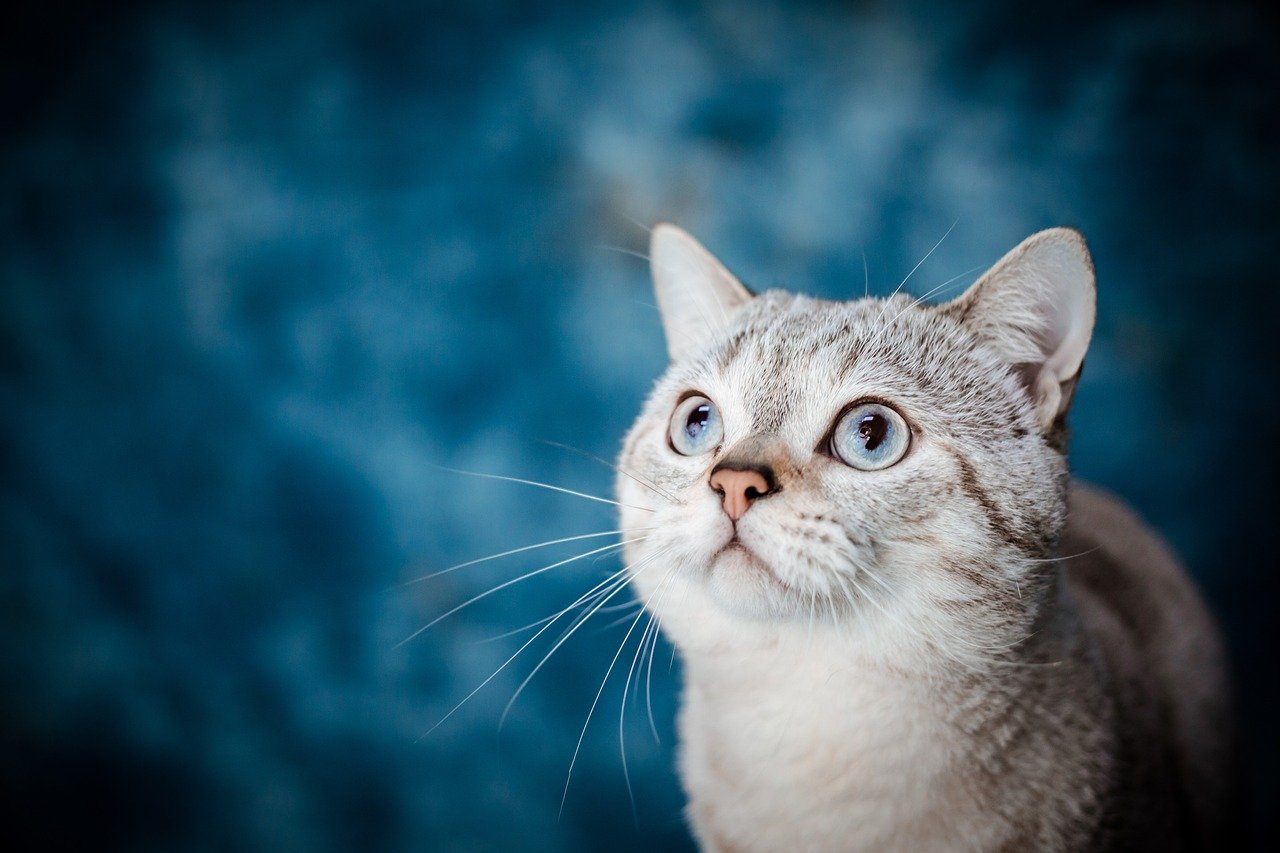
Establishing a Routine
Creating a consistent daily routine is not just a good idea; it's a lifeline for senior pets. Imagine how chaotic life would be without a schedule—think of all the confusion and anxiety that would arise! For our furry friends, especially the older ones, predictability is key. A well-structured routine can help them feel secure, knowing what to expect each day. This can significantly reduce their anxiety levels, making them feel more at home in their surroundings.
When we talk about routines, we're not just referring to feeding times. We're looking at a holistic approach that encompasses feeding, exercise, playtime, and rest. By establishing a regular feeding schedule, for instance, you can aid in digestion and create a sense of security for your senior pets. Think of it as a comforting rhythm that they can rely on, much like a favorite song that plays at the same time every day. A predictable feeding time can turn meal times into a stress-free experience, allowing them to enjoy their food without the worry of when it might come next.
In addition to feeding, incorporating a daily exercise routine is essential. Gentle walks or short play sessions can be integrated into their day-to-day activities. This not only helps maintain their physical health but also contributes to their mental well-being. Imagine a retired person who has a daily schedule filled with enjoyable activities; it keeps them engaged and active. Similarly, your senior pets can thrive on a routine that includes light exercise tailored to their abilities.
Moreover, daily check-ins are crucial. Just like we might check in on an elderly family member to see how they're doing, taking a moment to observe your senior pet's behavior can be incredibly beneficial. Are they moving comfortably? Are they eating well? These daily assessments allow you to catch any changes early, which can be vital for their health. If you notice anything unusual, it’s always best to consult with your veterinarian. After all, a little vigilance can go a long way in ensuring their happiness and longevity.
To sum it all up, establishing a routine for your senior pets is about creating a safe and predictable environment. It’s about making sure they feel secure, loved, and engaged. So, take the time to craft a daily schedule that works for both you and your pets. You might be surprised at how much happier and healthier they become when they have a routine to rely on!
- Why is a routine important for senior pets? A routine helps reduce anxiety and creates a sense of security, making pets feel more comfortable in their environment.
- How can I establish a feeding schedule? Choose specific times for feeding each day and stick to them to help your pet anticipate meal times.
- What types of exercise are suitable for senior pets? Gentle activities like short walks, light play, and even some mental exercises can keep them engaged without overexerting them.
- How can I monitor my senior pet's health? Daily check-ins on their behavior, appetite, and mobility can help you catch any changes early, allowing for timely veterinary attention.
Feeding Schedule
Establishing a for your senior pets is not just about keeping them fed; it's about creating a sense of routine that can significantly enhance their overall well-being. Think of it as setting the stage for a harmonious daily life where your furry friends know what to expect. Just like humans, pets thrive on predictability, and a consistent feeding schedule helps them feel secure and reduces anxiety.
When planning a feeding schedule, consider the specific dietary needs of your senior pets. Many older animals have unique health concerns, such as reduced metabolism or dental issues, which can affect their eating habits. It's essential to tailor their meals accordingly. For instance, if your pet has trouble chewing, you might want to opt for softer food or even wet food options. Additionally, dividing their daily food intake into smaller, more frequent meals can make digestion easier and promote better nutrient absorption.
Here’s a quick overview of how you might structure a feeding schedule for your senior pets:
| Time | Meal Type | Notes |
|---|---|---|
| 8:00 AM | Breakfast | Soft kibble mixed with wet food for easier digestion |
| 12:00 PM | Midday Snack | Small portion of treats or kibble |
| 5:00 PM | Dinner | High-quality senior food; ensure hydration |
| 8:00 PM | Evening Snack | Light treats or a small amount of wet food |
By adhering to a structured feeding schedule, you're not only helping your pets maintain a healthy weight but also promoting better digestive health. It's vital to monitor their weight regularly and adjust the portions as needed. If you notice any significant changes in their eating patterns or weight, don’t hesitate to consult your veterinarian. They can provide personalized advice tailored to your pet's specific needs.
Moreover, engaging in daily check-ins is an excellent way to keep tabs on your senior pets’ health. During these check-ins, pay attention to their appetite and behavior around meal times. Are they excited to eat, or do they seem disinterested? Any shifts in their enthusiasm for food can be a telltale sign of underlying health issues that may require veterinary attention. Remember, a happy pet is one that’s well-fed and taken care of!
- How often should I feed my senior pet? It's generally recommended to feed senior pets two to three times a day, depending on their specific needs and health conditions.
- What type of food is best for senior pets? Look for high-quality senior pet food that caters to their unique nutritional requirements, focusing on easily digestible ingredients.
- Should I change my senior pet's diet suddenly? No, any dietary changes should be made gradually over several days to avoid digestive upset.
- How can I tell if my senior pet is eating enough? Monitor their weight, energy levels, and overall behavior. If you notice any changes, consult your veterinarian.
Daily Check-ins
Daily check-ins are not just a routine; they are a vital part of ensuring your senior pets are thriving in their environment. Think of these check-ins as a daily health report card for your furry companions. By taking a few moments each day to observe your pets, you can catch any signs of discomfort or changes in behavior before they become serious issues. It's like being their personal detective, ensuring everything is as it should be.
During your check-in, pay close attention to their physical condition. Look for changes in weight, coat quality, and mobility. For instance, if your pet seems to be losing weight, it might be time to consult your veterinarian. Additionally, monitor their appetite and drinking habits; these can be significant indicators of health. If you notice anything unusual, jot it down. Keeping a simple log can help track changes over time, making it easier to discuss with your vet.
Another aspect of daily check-ins is evaluating their behavior. Are they still playful, or have they become more withdrawn? A sudden change in behavior can indicate underlying health issues. For example, if your once-energetic dog now prefers to lounge around, it could be a sign of pain or discomfort. Engaging with them during these check-ins can also strengthen your bond, making them feel loved and secure.
To make the most out of your daily check-ins, consider the following key areas:
- Physical Health: Check their weight, coat condition, and any signs of discomfort.
- Behavioral Changes: Look for shifts in activity levels or social interactions.
- Hydration and Nutrition: Ensure they are eating and drinking adequately.
By incorporating these elements into your daily routine, you not only enhance your pet's quality of life but also foster a deeper connection with them. Remember, a little attention can go a long way in ensuring your senior pets remain happy and healthy!
- How often should I check in on my senior pet? Daily check-ins are recommended to monitor their health and behavior closely.
- What signs should I look for during check-ins? Pay attention to changes in appetite, weight, mobility, and behavior.
- Should I keep a log of my check-ins? Yes, maintaining a log can help you track changes over time and provide valuable information to your veterinarian.
Frequently Asked Questions
- What are the unique needs of senior pets?
Senior pets often require special attention due to age-related health issues. They may need a tailored diet, regular veterinary check-ups, and a comfortable living environment to ensure their well-being. Understanding their physical limitations and emotional needs is crucial for their happiness.
- How can I create a safe environment for my senior pets?
To create a safe environment, you should remove hazards such as sharp objects and clutter that could lead to falls. Designating specific areas for each pet can help reduce stress and prevent territorial disputes. Additionally, maintaining clear pathways and providing comfortable resting spots are essential for their safety and comfort.
- What type of nutrition do senior pets need?
Senior pets often require a diet that is lower in calories but rich in essential nutrients to maintain their health. Consulting with a veterinarian can help you determine the best dietary plan tailored to your pet's specific health needs, ensuring they get the right balance of proteins, fats, and vitamins.
- How important is hydration for senior pets?
Hydration is crucial for senior pets as it helps prevent dehydration, which can lead to serious health issues. Always provide fresh water and monitor their intake to ensure they are drinking enough. Consider adding wet food to their diet to boost hydration levels.
- What kind of exercise is suitable for senior pets?
Gentle exercise routines, such as short walks or light play, are ideal for senior pets. These activities help maintain their mobility and prevent obesity without overexerting them. Tailoring exercise to their abilities keeps them active and engaged.
- How can I keep my senior pet mentally stimulated?
Using interactive toys and engaging in gentle play can stimulate a senior pet's mind. Activities that challenge them mentally, such as puzzle toys or simple training exercises, can keep them entertained and promote cognitive health.
- Why is establishing a routine important for senior pets?
Establishing a consistent daily routine helps senior pets feel secure and reduces anxiety. Predictability in feeding, exercise, and rest times fosters a sense of stability, which is beneficial for their overall well-being.
- How often should I check in on my senior pet's health?
Daily check-ins are recommended to monitor your senior pet's health and behavior. Observing any changes can help you detect potential health issues early, allowing for timely veterinary attention and care.

